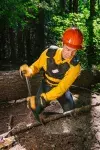
Fighting forest fires requires bravery, strength, and the right equipment.
While wildfires continue to rage across British Columbia, firefighter safety is top of mind for designer and Kwantlen Polytechnic University (KPU) alumnus Jaymes Williams. Williams is developing a device that will provide greater protection for those who battle blazes.
“These men and women put their lives on the line to protect us in an extreme environment that looks like hell on earth,” said Williams. “But how are they staying safe?”
As part of the product design program at KPU’s Wilson School of Design that he graduated from in 2016, Williams watched wildlands firefighters in action repelling from a helicopter. Afterwards, he talked to the crew about their personal experiences on the fire line and occupational health issues.
He learned that physically demanding work, long hours, heat and dehydration are the key instigators in the majority of firefighting accidents.
So Williams set out to design equipment that addressed the physical, psychological and emotional needs of wildlands firefighters. After testing multiple prototypes, Williams developed the Modular Accessory Carrying Harness (M.A.C.H), which provides easy access to communication, hydration, and storage.
Still in the prototype phase, the M.A.C.H provides storage for carrying equipment, houses a hydration pack and radio, is easy to strap on and off, and fits a small through large body frame.
The current harnesses and packs available for firefighters only exist as multiple separate items that must be purchased and strapped on individually. Williams knew there had to be a simpler more ergonomic solution that allowed maximum mobility and ease of use, and subsequently peace of mind, for wildfire crews.
“The work our students are doing is nothing short of mind blowing,” said Dr. Dan Robinson, design instructor andergonomics consultant. “Jaymes spent time with real firefighters, and through rigorous evidence-based research produced a practical highly useable tool to help them perform better in the field. That’s what good design is all about—solving real world problems by taking the time to understand the people and context that the design is intended to serve.”
According to Williams, the M.A.C.H is ready to be “real world” tested.
“My next step is to work with firefighters to further refine requirements of the harness including human factors, potential problems, and hazards,” said Williams. “A lot of the hard work is done, but I’ll definitely need the support of a large organization or the interest of a manufacturing company to make it ready for firefighters to use in the woods.”
To learn more about the innovative design projects Williams is working on, visit Posthinc.ca.
To learn more about or register for KPU’s product design program, visit kpu.ca/product-design.
Photos of Williams wearing the M.A.C.H harness are available on Flickr.
Key Facts:
- -Forest fires have burned more than 380,000 hectares of land in B.C. so far this year.
- -The annual cost of wildfire suppression by the B.C. government is about $182 million.
- -Reports of accidents, near misses, and demonstrably unsafe acts in the context of bushfire fighting identify human factors as the primary cause in 34 per cent of cases and as a leading cause in 80 per cent of cases
- -Wildlands firefighters are required to wear fire retardant long sleeve shirts, pants, gloves, and shrouds, as well as hard hats, goggles, ear protection, and leather shoes.
- -The hazards that must be addressed by protective equipment include physical, electrical, heat, chemicals, biohazards, and airborne particulate matter.
Story by Tatiana Tomljanovic
For more KPU news:
@KPUmedia
kpu.ca/newsroom
Flickr
RSS